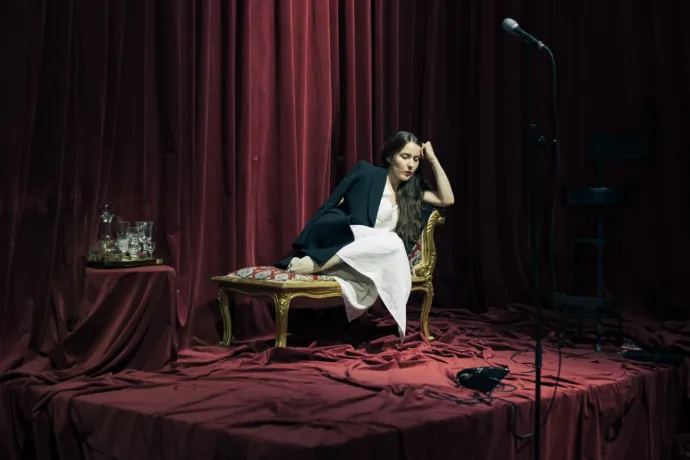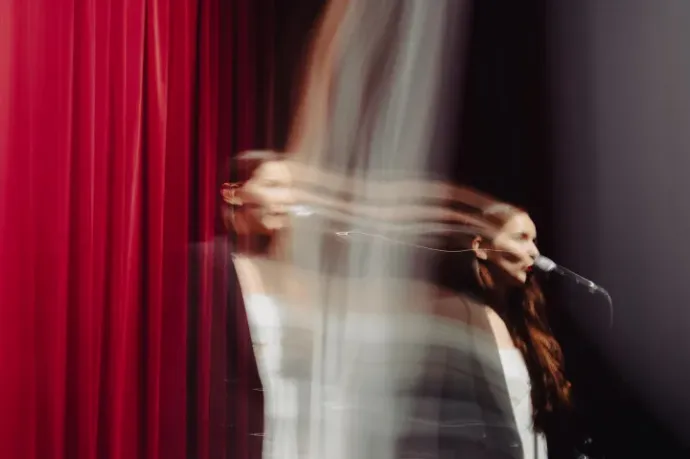From superstar to sensitive mentor – a Hungarian jazz singer took part in Marina Abramović's course

Opinions vary on whether Marina Abramović is the most exciting performance artist of all time, or a provocateur building on clichés. In any case, her influence on contemporary art is a strong argument in favour of the former: few living artists can fill the world's most important museum spaces alone and attract the crowds she does. Her 1974 performance Rhythm 0, in which she let the audience at a Naples studio do whatever they wanted to her for six hours, remains a fundamental reference point for the genre,. The pop cultural significance of her performance The Artist is Present, held at MoMA in New York in 2010, is also undeniable.
But it's also true that Abramović's character is an ideal target for irony. For example, Cate Blanchett's highly amusing performance in the parody series Documentary Now! shows us the fearless artist who will even set fire to the Hungarian National Gallery if necessary, just to realise her radical artistic idea. (In the episode, Abramović is presented as the fictional Hungarian-born artist, Izabella Barta, who returns to her hometown of Budapest for a retrospective exhibition.) But even in this very funny parody, the respect its makers showed for Marina Abramović's character shines through.
What was Marina like? Approachable, open and funny
Abramović was born in 1946, in post-war communist Belgrade, but has been living in New York for quite a long time, and her career and her suggestive personality are rightly attractive to fans. Anna Veronika Hargitai, born in 1994, first became acquainted with the name of the artist during her high school years in Pécs, and several of Abramović's works had a great influence on her. For example, her moving performance Balkan Baroque, presented at the 1997 Venice Biennale, in which the artist sang Serbian folk songs while crying on top of a bloody pile of bones. But she also likes the artist's works "about symbiotic relationships between two people", such as her performances with Ulay.
Anna Veronika Hargitai grew up in Pécs, and has been performing in theatre since the age of ten, having also studied classical voice training. She spent three years studying aesthetics and Hebrew studies at Eötvös Loránd University in Budapest, but finally settled on jazz. After her graduation from Bartók Conservatory in 2019, she was accepted for a four-year BA programme at Folkwang University of Arts in Germany. The late choreographer Pina Bausch once studied and taught at Folkwang, and the professorship programme named after her announced its first workshop course in 2022, for which Marina Abramović was invited to be a guest teacher.

Anna Veronika Hargitai thought that working with a performance artist was a once-in-a-lifetime opportunity – she even wrote this in her application. Of the approximately 300 applicants, 26 were accepted for the programme, including actors, dancers, classical and jazz musicians and physical theatre practitioners.
The course consisted of two semesters, three ten-day courses, followed by a twenty-day intensive workshop from morning to evening. "We worked in groups and individually, in person and online – it was all extremely focused. We watched videos, talked, and brainstormed. If someone, for example, came up with the idea of turning into a chicken during the performance, we contemplated where they could get enough feathers and how to fix them on their skin together.
What was particularly impressive was that Marina, at 76 years old, still worked with tremendous energy. We started each day with breathing and relaxation exercises, which were also led by her," the singer recalls. She says the superstar master quickly became a flesh and blood person in front of them.
“Marina was approachable, open and funny. She was both a New York City artistic icon and a sensitive mentor with a great sense of pedagogy and a desire to focus all her attention on her students.
She also approached the museum with the idea of exhibiting our final presentation there, and she put a lot of energy into making it happen. While sometimes she was as tough and stern as her public persona, essentially, she was a very natural person who would eat a sandwich from the cafeteria for lunch if she had to."

A beautifully draped room with Karády
Marina Abramović found Anna Veronika Hargitai's first ideas too pleasant, so she asked her to tell her about what was bothering her and what she was suffering from lately. "I answered that it was loneliness and homelessness, and she said that as an émigré from Eastern Europe, she could relate to that, and that she thought I should use this sadness artistically. She always encouraged us to be ourselves."
The performance was entitled In My Head It's a Neatly Draped Room and was intended as a projection experiment. "In a space richly draped with theatrical curtains, I tried to project my own feelings and thoughts. I was reflecting on the beautiful velvet-covered space that is our mind, our soul, a comfortable, dangerous, magical, but above all lonely place. I also imported the roles that patriarchal art has imposed on the role of the 'eternal woman', on divas, on drama queens, on the myth of the unbearable yet attractive female artist. All this was complemented by songs sung a capella, from jazz hits, through Boris Vian chansons to Karády songs."

The performance project took place in front of 10,000 visitors in the Folkwang Museum in Essen from 30 June to 9 July, between 10:00 a.m. to 6:00 p.m., without a break, for nine days.
"In the meantime we didn't leave our seats, we didn't go to the toilet, we didn't eat. But being tired or resting was also part of the performance."
– Anna Veronika Hargitai explains, adding that minimalism and slowing down have also been the hallmarks of Marina Abramović's recent works, and the artist told them about how she switched the rhythm of her meals during her MoMA performance, eating and drinking at night and sitting almost motionless in the museum from morning to night.
The singer shared that the project was mostly physically demanding for her. "Being present for six hours both mentally and emotionally is exhausting. Around the fifth day, I asked myself, if I was a fool for doing this. But fatigue or boredom are also part of these performances, and I consciously incorporated the resulting tension into my work. I found a state in which my presence and my energies were of primary interest, giving even the minimal activities a huge significance, which the visitors felt as well. There were some who watched for up to an hour as an emotion slowly unfolded in an act: in the singing of a song or the breaking of a glass."

When the bicycle and the microwave meet the hand-rolled cigarette
The 54-hour performance was a response to a variety of themes, with several artists addressing the issue of the climate crisis. A female clarinettist, for example, used a bicycle to generate energy for a kettle to compete with a microwave oven in heating up a glass of water, and there was a woman who rolled 5,000 cigarettes in a week and a half, as a reflection on consumerism. There was also a performance about the problem of queer life.
Since Marina Abramović was unable to fly due to complications from a knee operation, she was not present at the performance. Still, she was able to watch the rehearsals online during the final phase and was available in the evenings during the performance for anyone who had questions or doubts. (Her closest collaborator, co-curator Billy Zhao, was involved throughout.) And in parting, Abramović told the team that she was moved and very proud of them.
According to Anna Veronika Hargitai, her collaboration with the artist will also look good on her CV, and the interdisciplinary approach to her work made her more open and interested in genres beyond music. She would like to take part in similar projects in the future, and having already been approached by two Hungarian curators, there is a chance that this could happen. But unfortunately, she cannot yet give any details.
For more quick, accurate and impartial news from and about Hungary, subscribe to the Telex English newsletter!